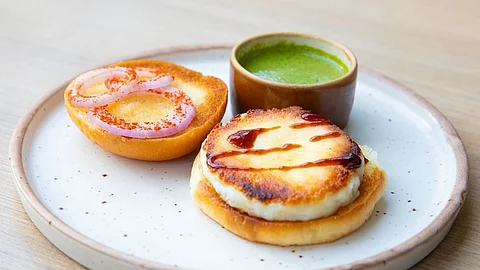
- HOMEGROWN WORLD
- #HGCREATORS
- #HGEXPLORE
- #HGVOICES
- #HGSHOP
- CAREERS
- ABOUT US
- CONTACT US

Some say it arrived with nomadic tribes from Central Asia. Others believe it is indigenous to the Jammu region. But whatever its origin, the artisanal cheese known as ‘doodh chapati’ in Hindi, ‘maish krej’ in Kashmiri, and ‘kalari’ in Dogri is easily one of India’s best-kept culinary secrets.
A traditionally ripened pasta filata or stretched-curd cheese, Kalari is made from full-fat cow, buffalo, or goat’s milk by the nomadic Gujjars — the largest scheduled tribe in Jammu and Kashmir — and other agro-pastoralist communities in the Jammu and Kashmir regions. To make Kalari, the raw milk is first warmed, and then vigorously churned with a wooden spoon. Next, the warm milk is curdled with thin, sour whey — a byproduct of the cheese-making process — locally known as ‘matthar’. The curdled milk solids are then separated from the whey, hand-pressed into small disc-shaped doughs, and dried in the sun for several days.
While Kalari made with buffalo or goat’s milk looks like a bright white balls of pressed dough, Kalari made with cow’s milk shows a slight yellow hue. Although there are differences in flavour based on the kind of milk used, Kalari in general has a dense, stretchy texture, and a mild mozzarella-like flavour but it changes with age. Fresh Kalari, for example, tastes mild and milky; however, the more it dries and ages, the more it becomes sour and pungent like some European blue cheeses.
There are also regional differences in how Kalari is made and consumed which contributes to how the cheese tastes. In towns like Udhampur and Reasi in the Jammu region, the Kalari made by womenfolk are smaller and softer as they are made with buffalo and goat’s milk. On the other hand, the nomadic Gujjars make Kalari with fresh, full-fat cow’s milk which gives the cheese a dark yellow colour. This darker cow's milk Kalari of the Gujjars resembles roti/chapati and is known as ‘Doodh chapati’ or ‘milk bread’.
Although food historians disagree on the origin of this artisanal, pastoral Himalayan cheese — with some tracing its origins to the heat-stretched cheeses of Central Asia and the Middle East, and others locating its origin in Jammu itself — it is widely accepted that the need to preserve milk in a shelf-stable form for long-term storage is what necessitated the invention of this cheese-making tradition.
A perennially popular street food in the Himalayas, Kalari is usually sautéed in fat — its own, vegetable oil, or animal fat — to infuse additional flavour and seasoned with salt before serving. Pan-fried Kalari, a popular savoury snack in Jammu, has a crisp, grilled-cheese-like crust on the outside and a soft, molten burrata-like core on the inside. Kalari is also used to make stuffed kulcha or flatbreads and used as stuffing for paav or any kind of bread to make a quick meal.
Until recently, Kalari was a hyperlocal ingredient only available in select pockets of Jammu and Kashmir. In recent years, however, online D2C sellers like Pahalgam-based Himalayan Cheese and Delhi-based Mirai-Maia have made significant progress in making Kalari available across India.
